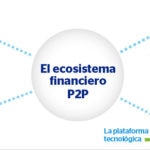What is the P2P financial ecosystem like?
The P2P financial market is booming around the world. With growth of 111%, it has become something more than an alternative: in 2012 it handled more than 2,099 million euros in over one million projects, according to the latest report by the consultancy firm Massolution. This is why we wanted to analyze all the agents that are part of this alternative funding ecosystem.

1. The entrepreneurs or borrowers
The boom experienced by the P2P financial ecosystem in recent years is largely due to the growing demand by entrepreneurs who need investments for their projects, but faced with the global economic difficulties and the credit squeeze during the crisis, encounter many barriers when trying to access the more traditional financial system.
In many cases these are small entrepreneurs who are looking for their first funding for their project or need an injection of capital to make their business idea a reality. However, they have no financial “reputation” to be able to access the traditional market with guarantees.

2. The investors or lenders
And the investors come into play to meet this growing demand by the entrepreneurs. They are an alternative in the traditional financial market, although they also have to overcome a series of barriers to be able to assess the projects that offer the greatest potential.
In fact, in the early stages of the projects, the investors are usually friends and relatives, but their involvement in the fundraising process disappears as the project progresses, according to an analysis by Agrawal, Catalini and Goldfarb.
Beyond these close investors, other lenders are appearing with the P2P financial market:
Through the so-called equity crowdfunding platforms, the microinvestors obtain shares or stakes in the company they invest in. They become the company's owners and the return on their investment is linked to the company's success and the distribution of profits.
Lenders
Through crowdlending platforms like LendingClub or Prosper, the investors lend money to the companies without becoming owners, as in the case of crowdfunding. Those who invest in this way receive a debit instrument that specifies the terms and conditions for repaying the loan. Thus, at the end of the stipulated period, they receive all the money lent plus a return that will depend on the risk assumed. The greater the number of investors, the more diversified becomes the risk among them. The minimum amount for investing is usually around €25.
The investor seeks nothing in exchange for the donation, so this is usually the case with charitable or humanitarian projects. It is collective funding, with no kind of remuneration in exchange.
Investors and future customers
Entrepreneurs can fund themselves through their future customers, instead of risking their own capital only. It goes one step further in the philanthropic nature of donations, as the investor is paying in advance for the service or product.
3. The financial capital and the price of this capital
In this traditional interplay of funding supply and demand, the entrepreneurs require capital which is offered by the investors, but they have to do so through what is known as a non-regulated market, the so-called shadow banking.
As we have seen, there are different "patronage" models: they can be donations for promoting the project or small investments in exchange for rewards such as having access to the product or service in which they invest, or investments in exchange for shares in the entrepreneur's startup.
4. The digital platform
In this context, the fourth piece in this ecosystem becomes increasingly essential: the technology platform that makes it possible for the other pieces in the mechanism to work, i.e. matching supply and demand, with their specific features, in a market that is becoming less and less "shadowy". This technology platform matches the incentives of the entrepreneurs and investors, while reducing the risks thanks to the support of technology.
This platform is the basis of the boom of this alternative ecosystem: the entrepreneurs can access funding that would be very difficult to obtain on the traditional market and, through the platform, can receive input from third parties about their project. Meanwhile, the investors can look for new investment opportunities and take part in the creation of a new project.
One of the disadvantages that must be mentioned is the risk taken by the entrepreneurs by having to publicly set out their projects and their business strategy without having finished it; while the investors run the risk of seeing how their business bet fails.
In turn, the platforms, as new market referees, have to ensure the quality of the projects they announce and, therefore, enhance their risk selection and management mechanisms. The goal of building loyalty and attracting more investors and their benefits are the fees and commissions.
The less stringent regulation of these markets and the higher degree of informality with which many of the platforms operate increase the liquidity and solvency risks faced by the investors".
5. Regulation
The operating rules for this ecosystem have not yet been established and are not as transparent as they should be for mitigating the risks of the investments. There is some uncertainty regarding the legislation to be applied to this alternative funding market, which in its early stages has developed with no specific regulation, hence the nickname "shadow banking".
The less stringent regulation of these markets and the higher degree of informality with which many of the platforms operate increase the liquidity and solvency risks faced by the investors. The lack of transparency and the information asymmetry between entrepreneurs and investors is much larger than on the strictly regulated traditional financial market.
In fact, specific regulations are beginning to emerge in the countries where this alternative funding system has developed more strongly, that regulate this activity by attempting, on the one hand, to protect unqualified investors and, on the other, to make it easier to access funding, especially for startups or small businesses, which find it difficult to fund themselves through more traditional channels.